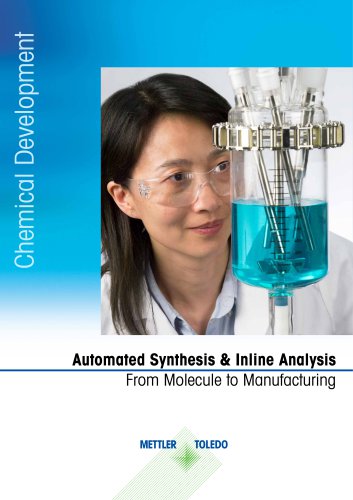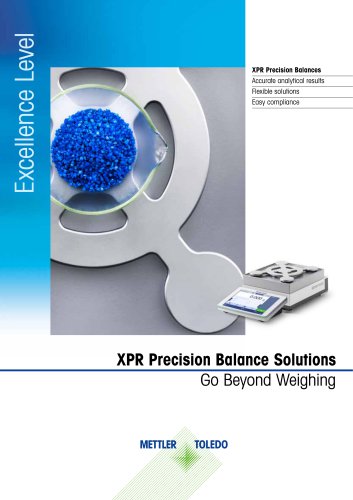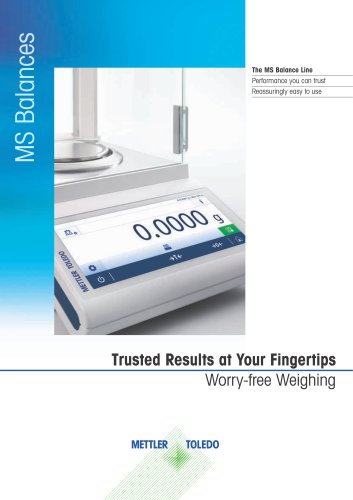 Website:
Mettler Toledo
Website:
Mettler Toledo
Group: Mettler Toledo
Catalog excerpts

Thermal Analysis Excellence Flash DSC 1 STARe System Innovative Technology Versatile Modularity Swiss Quality Flash Differential Scanning Calorimetry for Research and Development
Open the catalog to page 1
A Quantum Leap in Innovation Opens up New Frontiers Differential Scanning Calorimetry, DSC, is the most important method in thermal analysis. It measures the heat flow to or from a sample as a function of temperature or time and thereby allows physical transitions and chemical reactions to be quantitatively measured. The Flash DSC revolutionizes rapid-scanning DSC. The instrument can analyze reorganization processes that 1 were previously impossible to measure. The Flash DSC is the ideal complement to conventional DSC. Heating 1 rates now cover a range of more than 7 decades. Features and...
Open the catalog to page 2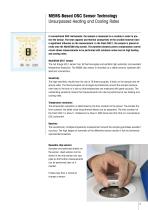
MEMS-Based DSC Sensor Technology Unsurpassed Heating and Cooling Rates In conventional DSC instruments, the sample is measured in a crucible in order to protect the sensor. The heat capacity and thermal conductivity of the crucible however have a significant influence on the measurement. In the Flash DSC 1, the sample is placed directly onto the MultiSTAR chip sensor. The patented dynamic power compensation control circuit allows measurements to be performed with minimum noise level at high heating and cooling rates. MultiSTAR UFS 1 Sensor The Full Range UFS 1 sensor has 16 thermocouples...
Open the catalog to page 3
Swiss Quality Flash DSC the Fastest 1 from METTLER TOLEDO Commercial DSC Sensor environment The sensor support is heatable. In the low-temperature operation, the sensor support can be brought to room temperature before the sensor is inserted. This prevents the gold contact pins from icing over. Terminal The large easy-to-read color touchscreen terminal at the front of the Flash DSC 1 indicates the status of the instrument. If the instrument is not next to your PC, — you can enter individual sequences and queries directly via the terminal. f'osh DSC l STAR* SystOT Complete thermal analysis...
Open the catalog to page 4
Ergonomic Perfection Is What Customers Value Perfect ergonomics The preparation and insertion of a sample is performed sitting comfortably in front of the instrument. The sample is first cut to size on a small glass microscope slide placed over the sensor. A suitable sample specimen is then transferred directly to the sensor and positioned using a hair. AGC Thermal Analysis Book 20% Cyan Sample preparation Sample preparation is carried out using a microscope. The microscope is also used to accurately position the very small sample specimen on the sensor. Application Handbook Thermal...
Open the catalog to page 5
Unbelievable Performance Leads to New Results Measurement principle High heating or cooling rates are only possible when the sample is sufficiently small and is in good thermal contact with the sensor. In the first heating run, the sample melts. Thermal contact with the sensor is thereby greatly improved. Defined sample structures can then be produced by varying the cooling rate over a wide range. Sample preparation Formation of sample structure Melting of the sample optimizes thermal contact. Different cooling rates allow defined sample structures to be formed. High heating rates suppress...
Open the catalog to page 6
Optimized Evaluation Software Brings Efficiency into the Laboratory Software support In a typical Flash DSC experiment, the measurement results are analyzed as a function of the heating or cooling rate or the isothermal time. The experiment is usually performed very quickly. Sample preparation needs somewhat more time. Evaluation and interpretation takes longest but is at the same time the most interesting part of the work. The STARe software has been expanded to include new requirements. For example, complex measurement programs are set up within a few minutes and large numbers of curves...
Open the catalog to page 7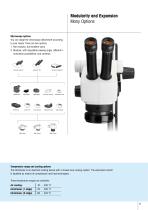
Modularity and Expansion Many Options Microscope options You can adapt the microscope attachment according to your needs. There are two options: 1. Not modular, but excellent value 2. Modular, with adjustable viewing angle, different illumination possibilities, and cameras. Video module Filter slide housing Video/photo tube Video/photo tube Light housing Temperature range and cooling options The IntraCooler is an electrical cooling device with a closed-loop cooling system. The vaporized coolant is liquefied by means of compressors and heat exchangers. Three temperature ranges are available:...
Open the catalog to page 8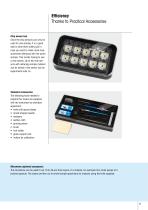
Chip sensor box Since the chip sensors can only be used for one sample, it is a good idea to store them safely just in case you want to make more measurements afterward with the same sample. This avoids having to use a new sensor. Up to ten chip sensors with adhering sample material can be stored in the sensor box for experiments later on. Standard accessories The following tools needed to prepare thin layers are supplied with the instrument as standard equipment: • knife with spare blades • lancet-shaped needle • tweezers • leather cloth • grinding stone • brush • hair holder • glass...
Open the catalog to page 9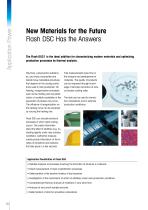
Application Power New Materials for the Future Flash DSC Has the Answers The Flash DSC is the ideal addition for characterizing modern materials and optimizing 1 production processes by thermal analysis. Polymers, polymorphic substances, and many composites and blends have metastable structures that depend on the cooling conditions used in their production. On heating, reorganization processes such as the melting and recrystallization of unstable crystallites or the separation of phases may occur. The influence of reorganization on the heating curve can be analyzed by varying the heating...
Open the catalog to page 10
Melting of indium at different heating rates The melting of indium (1 pg) was measured at different heating rates between 0.05 K/s and 10 000 K/s. As in conventional DSC, the conduction of heat between the sensor and the sample (thermal lag) influences the measured onset temperature, Ton. Without correction, Ton increases linearly with the heating rate. The same is true for the Flash DSC 1. To accommodate the large heating rate range, the abscissa is displayed logarithmically in the diagram. For this reason, the linear function appears as a curve (blue). Crystallization of isotactic...
Open the catalog to page 11All Mettler Toledo catalogs and technical brochures
-
XPR Precision Balances
20 Pages
-
GWP
2 Pages
-
Reaction Analysis and PAT tools
16 Pages
-
InMotion™ Autosamplers
16 Pages
-
Excellence Titrators
16 Pages
-
FiveEasy Bench Instruments
8 Pages
-
SevenExcellence™
20 Pages
-
MS Balance Line
24 Pages
-
Excellence Plus XP
20 Pages
-
XP Precision Balances
20 Pages
-
Excellence Melting Point Systems
12 Pages


